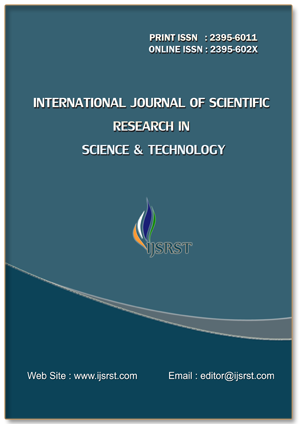Water Quality Assessment of Gomti River in District Sultanpur, Uttar Pradesh
DOI:
https://doi.org/10.32628/IJSRST24114147Keywords:
Total dissolved solids, Total suspended solids, Ph, hardness, dissolved oxygen, Chemical oxygen demand, Biochemical oxygen demandAbstract
The Gomti river begins in the district Pilibhit Uttar Pradesh, flow through the district of Sitapur, Lucknow, kheri, Barabanki, Sultanpur and Jaunpur unites with the Ganga, today the world struggling with a major type of Inorganic and Natural pollution. Gomti receives a lot of untreated agricultural sewage along with a lot of pesticides, fertilizer, and heavy metals. The purpose of this study is to determine the level of pollution in the Gomti River in Sultanpur district by analysing its Physio-chemical and bacterial parameters. The sample collection took place in 2023 at Four different sites -Golaghat, Sitakund Ghat, Dhobi Ghat, Shamshan Ghat. The following parameters were chosen for the physio-chemical analysis - Temperature, colour, Odor, Turbidity, Total hardness, pH, TDS, EC, Alkalinity, Free Ammonia, and Dissolved Oxygen (DO), Chemical Oxygen Demand (COD), Biochemical Oxygen Demand (BOD), Nitrate, Nitrite, Chlorine, Calcium, Magnesium, and some heavy metals, Iron, Chromium, Copper, Lead, Nickel, Selenium, Zinc, Mercury, Cyanide, are the Parameters chosen for the Physio- Chemical analysis. The standard procedure for the examination of water and wastewater, 21st edition (APHA- 2005) was adhered to in order to estimate the water Samples.
📊 Article Downloads
References
Surendra Kumar Pali, Mohd. Aftab Alam and Pankaj Kumar (2022). Assessment of Physio- chemical properties of the Gomti river Lucknow U.P DOI: https://doi.org/10.20546/ijcmas.2022.1106.005
Neeraj Kumar Srivastava and A.K. Srivastava (2012). Water Quality Assessment of Gomti River Around Industrial Area at Distt. Sultanpur.
APHA, (1999): standards methods for examination of water and waste water. American Public Health Association New York. P. 709.
Indian Standard Specifications for ingesting water, B.S. 10500. Government of India Boyacioglu, H. Development of a water nice index primarily based totally on a European category scheme. water SA, 33(1):101-106 (2007).
Ragini Singh, Anupam Kumar Gautam Physio-chemical analysis of Gomti River in different locations of Lucknow region (2022).
Maaz Shamsi, Sangeeta Bajpai, Monika Kamboj (2020). Physio-chemical Analysis of Gomti river in Lucknow city Uttar Pradesh. DOI: https://doi.org/10.30780/specialissue-ICACCG2020/017
Mishra Surya Prakash (2014). Analysis of water quality of Gomti River at District Sultanpur U.P.
Smitha, A.D. Shivshankar, A.P., (2013). Physio-chemical analysis of the freshwater at river Kapila, Nanjangudu industrial area, Mysore, India. J. Chem. Biol. Phys.Sci.25, 9-62.
Singh, K.P., Mohan, V.K.& Malik, A. (2005). Studies on distribution and fractions of heavy metals in Gomti river sediments- a tributary of a ganga, India. J. Hydra, 312, 14-27. DOI: https://doi.org/10.1016/j.jhydrol.2005.01.021
Dhananjay Kumar, Anjali Verma, Namita Dhusia and Nandkishor, water quality Assessment of Gomti river in Lucknow.
Siddiqui, A., Ali, Z. and Malhotra, S., 2015, Quality of water of Lucknow City: A Review Article. International journal of Engineering and Management Research ( JEMR), 5 (2),pp. 353-357.
Kumar A. And Shukla M. ( 2002) Physico- chemical features of Sai river at raibareli on the subject of its population. Journal of Eco - physiological occupation health ( 2).PP .33 – 38.
Vyas , A., Bajpai , A., & Verma, N., (2008) water quality improvement after shifting of idol immersion site, A case study of upper Lake , Bhopal, India . Environ Monit. Assess, 145 , 437- 443. DOI: https://doi.org/10.1007/s10661-007-0052-1
Sharma yashodhara and Verma Ashok (2003) pollution impact of tannery effluents on physico - chemical characteristics of river Yamuna at Agra, India. J Expt, Zool. India 6(1),75-81.
Ravi Prakash, S.L. and G. Krishna Rao 1989) . The chemistry of ground water Paravada area with regard to their suitability for domestic and Irrigation purpose. Indian journal Ceochem.4 (1):39-54.
Srivastava R.K. & Srivastava Seema+2003): Assessment of ground water quality of river Gaur at Jabalpur, Indian J. Env. Prot.23(3), 282-285.
Tiwari R. K., Rajak G.P. and Mondal M.R. (2005): Water quality assessment of ganga river in Bihar region, India. J. Environ Sci. Engng, 47(4), 326-355.
Srivastava Neeraj , Agrawal Meena and Tyagi Anupama (2003) : Physico-chemical characteristics of water body around Jaipur j. Environ Bio 24(2), 177-180.
Maiti S.K., (2001), Handbook of techniques in Environmental studies Vol.1 : water and waste water analysis. ABD publishers B- 46, Natraj Nagar, Imliwala phatak Jaipur, India. First edition.
Sankar Amita, Singh Arun Kumar and Mishra Prashant (2007), studies on physico chemical characteristics of Kheri Nadi water, Agra (U.P.) paper presented on 18th all India Congress of ZSI Lucknow Dec 7-9.
Sunil Kumar., Puttaiah, E. T., Manjappa S., Prakash NaikS. And Kumar Vijay (2006) : water quality assessment of river Tunga, Karnataka Env. Eco. 24. (5) (1), 23-26.
APHA, AWWA, WPCE, (2017). Standard Method for examination of water and waste water twenty third edition American Public Health Association, Washington, DC, New York, USA.
Downloads
Published
Issue
Section
License
Copyright (c) 2024 International Journal of Scientific Research in Science and Technology

This work is licensed under a Creative Commons Attribution 4.0 International License.
https://creativecommons.org/licenses/by/4.0




